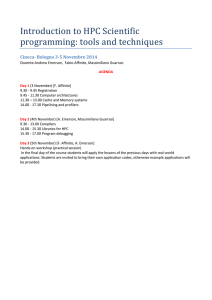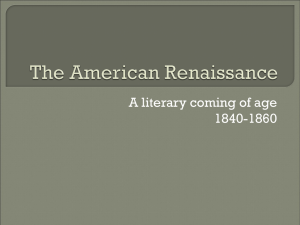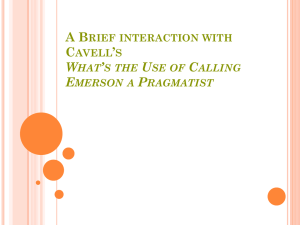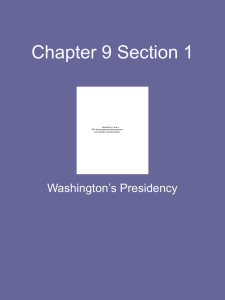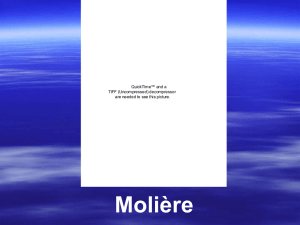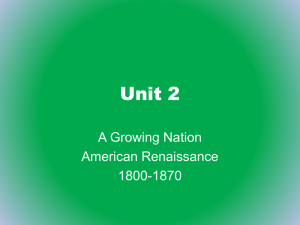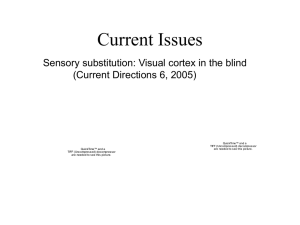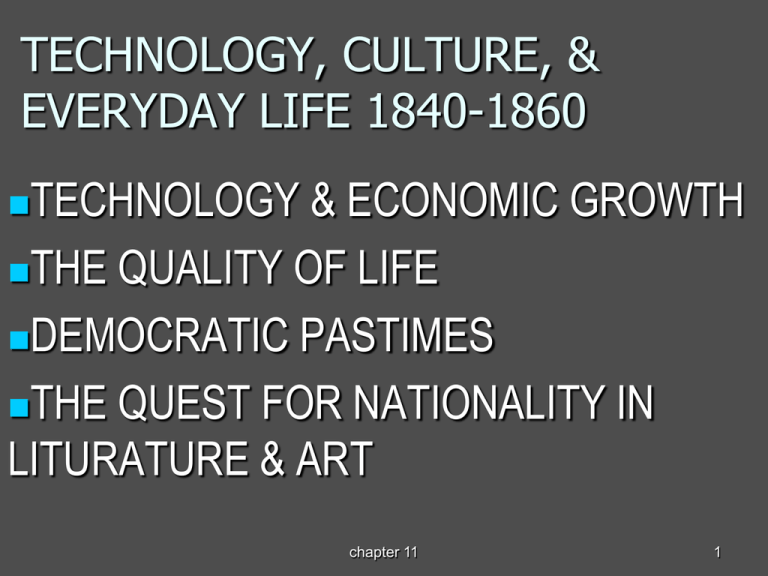
TECHNOLOGY, CULTURE, &
EVERYDAY LIFE 1840-1860
TECHNOLOGY
& ECONOMIC GROWTH
THE QUALITY OF LIFE
DEMOCRATIC PASTIMES
THE QUEST FOR NATIONALITY IN
LITURATURE & ART
chapter 11
1
How did technology transform the daily lives of
ordinary Americans fr. 1840-1860?
Technological change contributed to new kinds
of national unity and also to new forms of social
division. What were the main unifying features
of technology? The principal dividing or
segmenting features?
How did the ways in which Americans passed
their spare time change between 1840 and
1860?
What did American writers and artists see as the
distinguishing features of their nation? How did
their views of American distinctiveness find
expression in literature, painting, and landscape
architecture?
chapter 11
2
(Chapter 11) Model of McCormick’s
Reaper 1850s
Cyrus McCormick invented a mechanical
wheat reaper in his native Virginia in 1831,
patented it in 1834, and kept improving it until
his death fifty years later. Like many antebellum
inventions, the reaper saved labor and hence
wages, which were comparatively high in
America. The amount of time required to harvest
an acre of wheat dropped from twenty hours in
1830 to one hour by 1895.
McCormick was just one of many clever
inventors trying to make a mechanical reaper. A
rival, Obed Hussey, had patented a similar
machine a year before McCormick, and in the
1840s the courts upheld Hussey's patent, not
McCormick's. But McCormick is the name we
remember. Unable to stop Hussey from
producing reapers, McCormick had become a
millionaire by 1857. His formula for success was
simple. First, in order to gain control of
production of all reapers with his name on it he
stopped hiring individual contractors to produce
reapers. Instead, he moved to Chicago, started
his own factory, standardized production to
control quality, and aggressively marketed his
reapers by offering money-back guarantees and
deferred payments.
1.
How did the new techniques of mass
production in the 1840s and 1850s affect the
business side of industry, notably the
marketing of products?
(Chapter 11)
Model of McCormick’s Reaper
Technology & Economic Growth: Agricultural
Advancement
John Deere: steel-tipped plow to clear
land
Cyrus McCormick (Va): mechanical
reaper to harvest wheat grains 7
times faster…$$
Helped North win Civil War
Eli Whitney: cotton gin stimulated
cotton economy
Fertilizer to improve production gap
between rich soil in West and scarce
one in East
chapter 11
5
Technology & Economic Growth: industrial
growth
Industrial advances by effective
machine tools that cut metal
US (Vermont) perfected
manufacturing of interchangeable
parts (Eli Whitney)
Europeans called process “American
system” although machine tools started
in Britain
Smith & Wesson mass produced
revolving pistol (by Samuel Colt)
Samuel F.B. Morse: 1st telegraph
chapter 11
6
Map 11.1:
Railroad
Growth, 1850–
1860
Technology & Economic Growth: Railroad
More than telegraph, railroad
dramatized technology’s democratic
promise
Extended tracks 3Th to 30Th miles;
telegraph facilitated
scheduling/communication
1860, US had more tracks than the
world’s
Tracks fueled city growth & links &
small towns
Railroad: 1st US big business; made
chapter 11
8
Technology & Economic Growth: Rising
Prosperity
Luxury goods cheaper: $50 clock to
50 cents
Worker’s real income rose 25%
Growth of cities/towns provide more
jobs year round
Offer wages to children/women, much
needed income for household
Farm workers (not owners) fared worse
than city wage earners
Urban families experienced increased
comfort & convenniences
chapter 11
9
Quality of Life: Dwellings
18th
century: unattached frame
houses; 19th C. brick row houses
Working class: subdivided row
houses called tenements (Irish &
free blacks)
Wealthy: houses around park;
Tech. advances in making
furniture: level taste between
upper and middle class
chapter 11
10
Quality of Life: Conveniences &
Inconveniences
Wood scarce: coal burning stove
Stove: cooking several dishes at
once & contributed to variety of
diet (railroad brings fresh produce)
Improved water systems:
aqueduct, but 1 in 5 took one bath
a year
Elegance and squalor at the same
time: pollution
Poor still ate salted pork, mostly
Rich: running water & flushed
toilettes; poor used outdoor privies
and hogs (yummy dinner
sometimes)
chapter 11
11
chapter 11
12
Quality of Life: diseases and health
Shipping routes bring
cholera epidemic of 1832
(1/5 of N. Orleans)
William T.G. Morton used
anesthetics (sulfuric ether,
laughing gas) during
operation in 1846
Est. municipal health board:
distrust of physicians led to
health as low priority
Miasma theory: toxic gases
(by rotting veg. & dead
animals) cause diseases
Improved image of physicians
Got anesthetics but failed to
clean hands before surgery
chapter 11
13
Quality of Life: Health improvement
Distrust physicians led to hydropathic
sanatoriums (water cure, afforded by
middle class women)
Advice from Sylvester Graham: abstinence
from meat, spices, coffee, & tea, + SEX
Meat stimulated lust and agression
Use revival language: disease as hell, health
as heaven
chapter 11
14
(Chapter 11) Phrenological Head
Originating in Europe in the 1790s, the
"science" of phrenology maintained that each
personality trait, good or evil, is controlled by its own
distinct organ in the brain and that the size of that
organ determined how powerful an influence it
would exert in a person's life. Thus, an examination
of the contours of an individual's skull would reveal
both overdeveloped and underdeveloped traits.
Phrenology appealed to the desire of
antebellum Americans for self-betterment. Many
intellectuals and social reformers, including Horace
Mann, Sarah Grimké, and Horace Greeley,
embraced phrenology. In this illustration, Lorenzo
Fowler, the editor of the Phrenological Almanac and
his brother Orson, a leading popularizer of the
movement, attached a picture to each faculty so that
a reader could not fail to make the right
associations. For example, box 14, showing a man
pulling a mule, locates the organ of stubbornness;
number 18, a boy bowing before an elder, that of
respect; the two boys scrapping (behind the ear),
that of combativeness.
Even as phrenology was becoming a fad,
church membership was on the rise, and most
American Christians avowed belief in Original Sin
and the existence of the soul. In principle, a
person's soul was unitary, a single spiritual entity
that was either possessed or not possessed of
divine grace. By locating multiple traits in the
physical composition of the brain, phrenology
seemed to conflict with Christianity. Interestingly,
most phrenologists were religious.
1.
The popularity of phrenology among both
reformers and the broader public raises
questions. Were there benefits that an individual
might expect to gain from phrenology beyond
the self-satisfaction of improving oneself?
2.
How might the popularity of phrenology have
reflected the transportation revolution and the
changing nature of business?
3.
What does the popularity of phrenology say
about American Christianity in the midnineteenth century?
(Chapter 11)
Phrenological Head
Quality of Life: Phrenology
Orson Fowler: human mind comprised 37
distinct faculties that shaped skull, which
can be used to analyze one’s character
His books advice against evils of coffee,
tea, meat, spices & SEX (familiar??
Graham)
chapter 11
17
DEMOCRATIC PASTIMES: NEWSPAPER
Newspaper, not popular but profitable,
multiplied
Limited appeal: lacked exciting news &
eye catching illustrations
Tech.: steam-driven cylindrical presses
Now one penny instead of 6
Penny paper invented “news” with human
stories of rape, murder, orphans
Used telegraph to speed news into print
James Gordon Bennett: NY Herald
chapter 11
18
DEMOCRATIC PASTIMES: Theater
Served mass audience: 2-4 Thousand;
“that dark, horrible, guilty place” = top
gallery for prostitutes
Riot of 1849 (22 dead) over 2 US and Br
actors reflected class friction: working
men vs. aristocrat
Adjusted Shakespeare to audience: Julia
at 18, not 14
chapter 11
19
DEMOCRATIC PASTIMES: Minstrel Shows
1840-50s
Forged stereotypes, buttressed white
Americans’ sense of superiority
diminishing black people
Arose in the North & spread all the
way to San Francisco: Even in
Whitehouse
Borrowed African American culture &
songs had origins of white culture
Stephen Foster’s songs: “Camptown
Races” and “Massa’s in the Cold
Ground”
Notion of how blacks sang
Catered to prejudice of working class
whites: blacks as clumsy, stupid,
obsessively musical
chapter 11
20
DEMOCRATIC PASTIMES:
P.T. Barnum
“a hustler raised in the land of the Puritans, a
cynic and an idealist rolled into one”
Open the American Museum in NYC for
entertainment, not education
Show collections of curiosities & faked
exhibits: winged men on the moon
Achieved publicity by his (various names)
letters to newspaper hinting about science of
astonishing nature
Lecture on evils of alcohol making museum a
safe place
chapter 11
21
Nationality in Literature and Art
American Renaissance derived from
economic & philosophical (romanticism)
factors: Democratize literature
Transportation bred national market for
books
Sir Walter Scott (Br): Waverly (fiction)
James Fenimore Cooper
Harriet Beecher Stowe: Uncle Tom’s Cabin
Romanticism as reaction to classicism: lit.
work to be emotionally charged & reflects
author’s inner feelings
chapter 11
22
Literature & Art: literary figures
J. F. Cooper: The Pioneers, The Last of the
Mohicans. Pathfinder, Deerslayer
The Pioneers reflect theme of nature against
civilization
Ralph Waldo Emerson 1830s: led transcendentalist
movement, US offshoot of romanticism: our
ideas of God & freedom are inborn, Americans
ought to trust themselves. Essayist
Henry D. Thoreou: an Emersonian but
adventurous; went to jail instead of paying poll
tax, which suported war w/ Mexico, a way for
Southerners to extend slavery; retreated to
Walden & wrote about his experience
chapter 11
23
Literature & Art: M. Fuller, W. Whitman
Margaret Fuller: An Emersonian: Charged
a fee for presiding over “Conversations”
Participants both elite men and women of
Boston
Woman in the Nineteenth Century: classic
feminism 1845
Called for women to overcome fear of being
masculine to achieve personal fulfillment
Walt Whitman: an Emerson, wrote Leaves
of Grass (book of poems in free verse)
1855 “The scent of these armpits finer
than prayers” or “winds whose softtickling genitals rub against me”
11
Vulgar poems but chapter
enthralled
Emerson
24
Literature & Art: Hawthorne, Melville, & Poe,
contrast w/ Emerson’s call for every experience
as truth
The 3 used unusual settings, interested in
psychology & the intricacies of the human mind,
not social relationships
Nathaniel Hawthorne’s The Scarlet Letter
Saw humans as bundles of conflicting forces
Characters obsessed by pride, guilt, revenge,
perfection…reflect their pessimistic view
Psychological/moral consequences of adultery
Moral dilemmas of central charaters
Herman Melville’s Moby-Dick: obsession of revenge
of the white whale led to death
Edgar Allan Poe’s The Fall of the House of Usher”:
symbol of crumbling house w/ mental agony of a
crumbling family
chapter 11
25
Literature & Art: in the Market Place1
18th C. notion: lit. & art are above commercial
Emily Dickinson refused to published her poems
But authors were often tempted & compelled to
write for profit
Poe, drinker, pressed for cash, wrote short
stories for popular magazines
Thoreau wanted publicity for his poems but
failed
Emerson became a lyceum lecturer, his essays
originated as lectures; fees were his income
Susan Warner’s The Wide, Wide World: wrote
fiction for $ & pleasure
chapter 11
26
Roots of the American
Renaissance
The economy and the philosophy were leading developments contributed to
the development of the American Renaissance
The revolution created a national market for books
American Renaissance reflected the rise of philosophical movement known
as romanticism
Use of literature came from their knowledge of ancient Greek and Roman
civilization
Many of the best selling novels were written by women writers
Harriet Beecher Stowe wrote Uncle Tom’s Cabin
Authors created character, situation, and outcomes
•
Essays and novels eventually followed
James Fenimore Cooper
The first important figure in literary upsurge
Most significant innovation was to
introduce a distinctively
American fictional
character
Wrote numerous seastories
QuickTime™ and a
TIFF (Uncompressed) decompressor
are needed to see thi s picture.
Ralph Waldo Emerson
QuickTime™ and a
TIFF (Uncompressed) decompressor
are needed to see this picture.
Wrote no novels
Most influential spokesman for
American literary nationalism
Emerson broke with the
traditional view that ideas arise
from the toil of human reason
Stated that knowledge
resembles sight
Addressed “The American
Scholar”
Leader of the philosophical
movement of
Emerson continued…
He had a magnetic attraction for intellectually inclined
young men and women who did not fit neatly into
American society
He was not adventurous in action
QuickTime™ and a
TIFF (Uncompressed) decompressor
are needed to see this picture.
Henry David Thoreau
QuickTime™ and a
TIFF (Uncompressed) decompressor
are needed to see this picture.
QuickTime™ and a
TIFF (Uncompressed) decompressor
are needed to see this picture.
Was a representative of the younger
Emersonians
Thoreau was known as a doer
Moved from Concord to the woods
near Walden Pond
Most of his painting came from visuals
in the woods
Wrote a book during his stay in the
woods
Walden
The book was filled with
descriptions of hawks and
wild pigeons, his invention
raisin bread, and his
trapping of woodchucks
Margaret Fuller
Margaret Fuller’s status as an intellectual woman distanced her from
conventional society
Her father attended Harvard and he was a prominent Massachusetts
politician
She was exposed to Emerson’s ideas toward transcendentalism, a
group of new ideas, religion, or culture
Transcendentalism influenced her classic of American feminism,
Woman in the Nineteenth Century
Qui ckTime™ and a
TIF F (Uncompressed) decompressor
are needed to see thi s picture.
Walt Whitman
Qui ckTime™ and a
TIF F (Uncompressed) decompressor
are needed to see t his picture.
Qui ckTime™ and a
TIF F (Unc ompress ed) dec ompress or
are needed to see t his pict ure.
Self-taught
Was in love with everything that
associated with America, except
slavery
Left school at eleven and became a
printer’s apprentice and later a
journalist
Journalism and politics gave
Whitman an intimate knowledge of
ordinary Americans
Major work, Leaves of Grass
Wrote in free verse, his poems had
neither rhyme nor meter
Nathaniel Hawthorne, Herman Melville,
Edgar Allan Poe
Expressed themselves in writings
Primarily wrote fiction
Paid little heed to Emerson’s call for literature that would comprehend the
everyday experiences of ordinary Americans
Their pessimism led them o create characters obsessed by pride, guilt, and
desire
Hawthorne focused on the moral dilemmas that he conveyed in social life
Melville created frightening characters
Poe also channeled his pessimism into creative achievements
Nathaniel Hawthorne
Qu ickT im e™ an d a
T IF F (Un co mp re ss ed ) d ec om p re ss or
a re ne ed ed to s ee th is pic tu re .
Herman Melville Edgar Allan Poe
Qui ckTime™ and a
TIF F (Uncompressed) decompressor
are needed to see t hi s picture.
Qu ickT i m e™ an d a
T IF F (Un co mp re ss ed ) d ec om p re ss or
a re ne ed ed to se e th is pic tu re.
Literature & Art: Landscape Painting
The Hudson River School flourished 1820s1870s
Thomas Cole’s The Course of the Empire
Theme: luxury doomed Republican virtue
Frederick Church, Cole’s student, painted the
Andes Mountains
Asher Durand
The three painted Hudson River landscapes,
interests sparked by Erie Canal
Emerson and Thoreau popularized view of
nature; painters also reacted against envir.
Degradation
chapter 11
35

